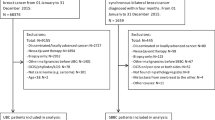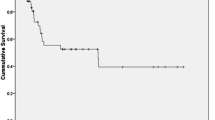Abstract
Background
Bilateral breast cancer (BC) has an incidence of 1 to 3 %. This study aimed to describe the clinicopathologic characteristics and management of bilateral BC, estimate disease-free survival (DFS), and compare DFS with unilateral BC.
Methods
A retrospective analysis was performed for patients who had bilateral invasive BC or unilateral invasive BC and contralateral ductal carcinoma in situ (DCIS) treated at Mayo Clinic Rochester from 2008 to 2022. A 4:1 matched cohort of patients with unilateral invasive BC was used for comparison. The groups were compared using Wilcoxon rank-sum or chi-square tests. Disease-free survival was analyzed using the Kaplan-Meier method and log-rank test, with Cox proportional hazards regression used for multivariable analysis.
Results
The study identified 278 cases of bilateral breast cancer (177 cases of bilateral invasive cancer and 101 cases of unilateral invasive cancer with contralateral DCIS), representing 4.1 % of invasive BCs. Biologic subtype was concordant between sides in 79.8 % of the patients. Initial surgery was bilateral mastectomy for 76.6 %, bilateral lumpectomy for 20.5 %, and unilateral mastectomy with unilateral lumpectomy for 2.9 % of the patients. Pathogenic variants in breast cancer predisposition genes were present in 21.7 % of those tested. The patients who had bilateral BC presented with a higher cT category than the patients who had unilateral BC (p = 0.02), and a higher proportion presented with ILC (17.3 % vs 10.9 %; p = 0.004), estrogen receptor-positive (ER+) disease (89.2 % vs 84.2 %; p = 0.04), multicentric/multifocal disease (37.1 % vs 24.3 %; p < 0.001), breast cancer pathogenic variant (21.7 % vs 12.4 %; p = 0.02), and palpable presentation (48.2 % vs 40.8 %; p = 0.03). The patients with bilateral BC showed DFS similar to that for the unilateral BC cohort (p = 0.71).
Conclusions
Bilateral BCs most commonly are biologically concordant between sides. Bilateral BC presented more commonly with larger tumors, lobular histology, ER+ status, multicentricity or multifocality, pathogenic variant, and palpable disease. Bilateral BC is not associated with worse DFS than unilateral BC.




Similar content being viewed by others
References
Holm M, Tjonneland A, Balslev E, Kroman N. Prognosis of synchronous bilateral breast cancer: a review and meta-analysis of observational studies. Breast Cancer Res Treat. 2014;146:461–75.
Irvine T, Allen DS, Gillett C, Hamed H, Fentiman IS. Prognosis of synchronous bilateral breast cancer. Br J Surg. 2009;96:376–80.
Nichol AM, Yerushalmi R, Tyldesley S, et al. A case-match study comparing unilateral with synchronous bilateral breast cancer outcomes. J Clin Oncol. 2011;29:4763–8.
Verkooijen HM, Chatelain V, Fioretta G, et al. Survival after bilateral breast cancer: results from a population-based study. Breast Cancer Res Treat. 2007;105:347–57.
Therneau T. A Package for Survival Analysis in R. R package version 3.4-0 2022. Retrieved at https://cran.r-project.org/web/packages/survival/index.html, 2023.
Renz DM, Bottcher J, Baltzer PA, et al. The contralateral synchronous breast carcinoma: a comparison of histology, localization, and magnetic resonance imaging characteristics with the primary index cancer. Breast Cancer Res Treat. 2010;120:449–59.
Baretta Z, Olopade OI, Huo D. Heterogeneity in hormone-receptor status and survival outcomes among women with synchronous and metachronous bilateral breast cancers. Breast. 2015;24:131–6.
Marpeau O, Ancel P-Y, Antoine M, Uzan S. Barranger E [Synchronous bilateral breast cancer: risk factors, diagnosis, histology and treatment]. Gynecol Obstet Fertil. 2008;36:35–44.
Mejdahl MK, Wohlfahrt J, Holm M, et al. Synchronous bilateral breast cancer: a nationwide study on histopathology and etiology. Breast Cancer Res Treat. 2020;182:229–38.
Intra M, Rotmensz N, Viale G, et al. Clinicopathologic characteristics of 143 patients with synchronous bilateral invasive breast carcinomas treated in a single institution. Cancer. 2004;101:905–12.
Beckmann KR, Buckingham J, Craft P, et al. Clinical characteristics and outcomes of bilateral breast cancer in an Australian cohort. Breast. 2011;20:158–64.
Cocco D, ElSherif A, Wright MD, et al. Invasive lobular breast cancer: data to support surgical decision making. Ann Surg Oncol. 2021;28:5723–9.
Santiago L, Whitman G, Wang C, Dogan BE. Clinical and pathologic features of clinically occult synchronous bilateral breast cancers. Curr Probl Diagn Radiol. 2018;47:305–10.
Bergthorsson JT, Ejlertsen B, Olsen JH, et al. BRCA1 and BRCA2 mutation status and cancer family history of Danish women affected with multifocal or bilateral breast cancer at a young age. J Med Genet. 2001;38:361–8.
Carmichael AR, Bendall S, Lockerbie L, Prescott R, Bates T. The long-term outcome of synchronous bilateral breast cancer is worse than metachronous or unilateral tumours. Eur J Surg Oncol. 2002;28:388–91.
Jobsen JJ, van der Palen J, Ong F, Meerwaldt JH. Synchronous, bilateral breast cancer: prognostic value and incidence. Breast. 2003;12:83–8.
Levi F, Randimbison L, Te V-C, La Vecchia C. Prognosis of bilateral synchronous breast cancer in Vaud. Switzerland. Breast. 2003;12:89–91.
Kollias J, Ellis IO, Elston CW, Blamey RW. Prognostic significance of synchronous and metachronous bilateral breast cancer. World J Surg. 2001;25:1117–24.
Vuoto HD, Garcia AM, Candas GB, et al. Bilateral breast carcinoma: clinical characteristics and its impact on survival. Breast J. 2010;16:625–32.
Takahashi H, Watanabe K, Takahashi M, Taguchi K, Sasaki F, Todo S. The impact of bilateral breast cancer on the prognosis of breast cancer: a comparative study with unilateral breast cancer. Breast Cancer. 2005;12:196–202.
Heron DE, Komarnicky LT, Hyslop T, Schwartz GF, Mansfield CM. Bilateral breast carcinoma: risk factors and outcomes for patients with synchronous and metachronous disease. Cancer. 2000;88:2739–50.
Kheirelseid EAH, Jumustafa H, Miller N, et al. Bilateral breast cancer: analysis of incidence, outcome, survival and disease characteristics. Breast Cancer Res Treat. 2011;126:131–40.
Hungness ES, Safa M, Shaughnessy EA, et al. Bilateral synchronous breast cancer: mode of detection and comparison of histologic features between the 2 breasts. Surgery. 2000;128:702–7.
Heaton KM, Peoples GE, Singletary SE, et al. Feasibility of breast conservation therapy in metachronous or synchronous bilateral breast cancer. Ann Surg Oncol. 1999;6:102–8.
Hartman M, Czene K, Reilly M, et al. Incidence and prognosis of synchronous and metachronous bilateral breast cancer. J Clin Oncol. 2007;25:4210–6.
Lehman CD, Gatsonis C, Kuhl CK, et al. MRI evaluation of the contralateral breast in women with recently diagnosed breast cancer. N Engl J Med. 2007;356:1295–303.
Acknowledgment
Dr. Boughey receives research support paid to her institution from Eli Lilly and SymBioSis and is on a DSMC for CairnsSurgical. She has received honoraria for speaking for PER, PeerView, and EndoMag, and has contributed a chapter to UpToDate.
Author information
Authors and Affiliations
Corresponding author
Ethics declarations
Disclosure
There are no conflicts of interest.
Additional information
Publisher's Note
Springer Nature remains neutral with regard to jurisdictional claims in published maps and institutional affiliations.
Supplementary Information
Below is the link to the electronic supplementary material.
10434_2023_14451_MOESM1_ESM.tiff
Supplementary file1 FIG. S1 Disease-free survival by type of surgery in the bilateral breast cancer cohort restricted to the subgroup with a preoperative diagnosis of invasive cancer in both breasts
10434_2023_14451_MOESM2_ESM.tiff
Supplementary file2 FIG. S2 Disease-free survival for the subgroup of bilateral patients with preoperative diagnosis of invasive disease in both breasts versus patients with unilateral invasive breast cancer
Rights and permissions
Springer Nature or its licensor (e.g. a society or other partner) holds exclusive rights to this article under a publishing agreement with the author(s) or other rightsholder(s); author self-archiving of the accepted manuscript version of this article is solely governed by the terms of such publishing agreement and applicable law.
About this article
Cite this article
Schulze, A.K., Hoskin, T.L., Moldoveanu, D. et al. Tumor Characteristics of Bilateral Breast Cancer Compared with Unilateral Breast Cancer. Ann Surg Oncol 31, 947–956 (2024). https://doi.org/10.1245/s10434-023-14451-x
Received:
Accepted:
Published:
Issue Date:
DOI: https://doi.org/10.1245/s10434-023-14451-x




